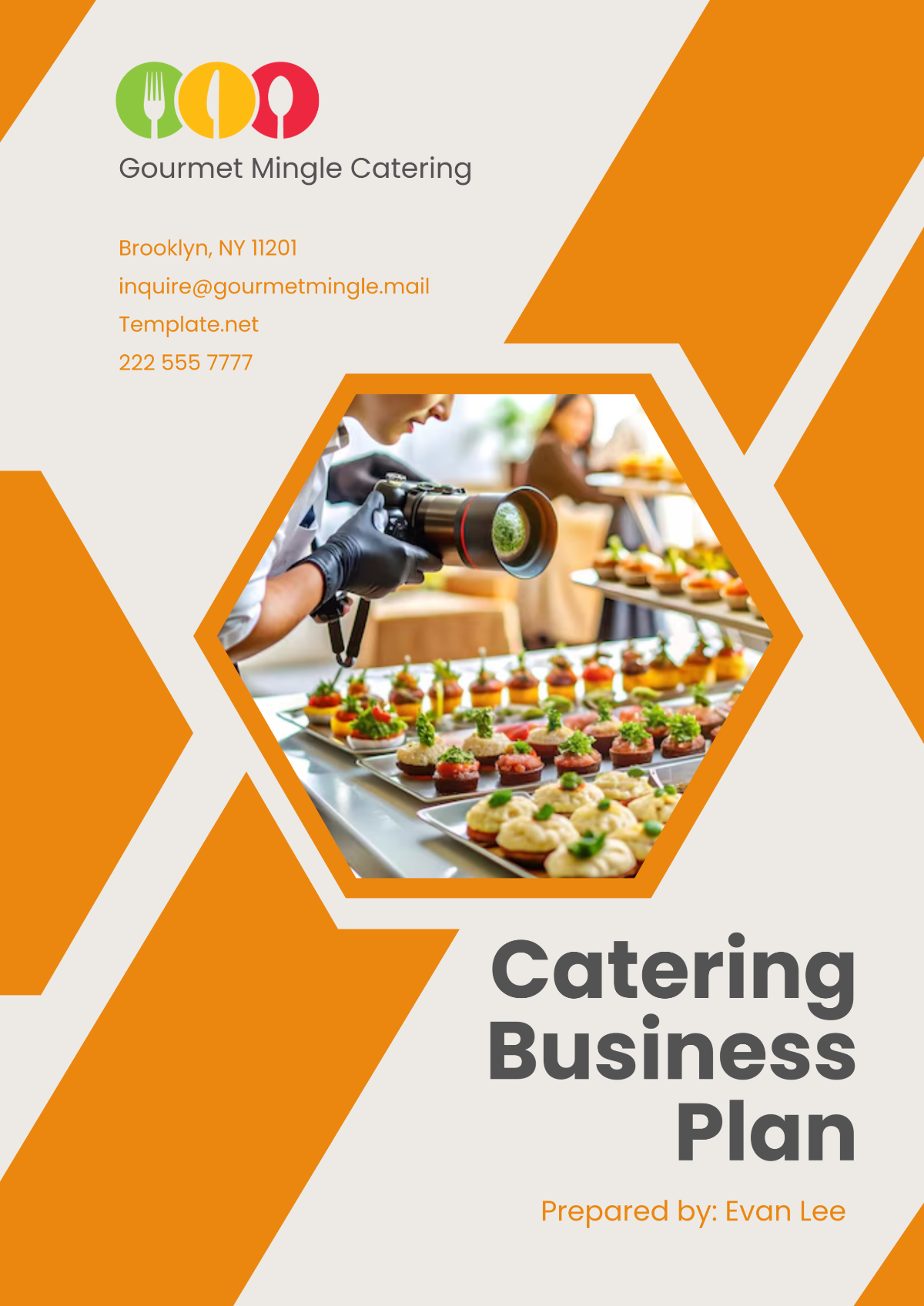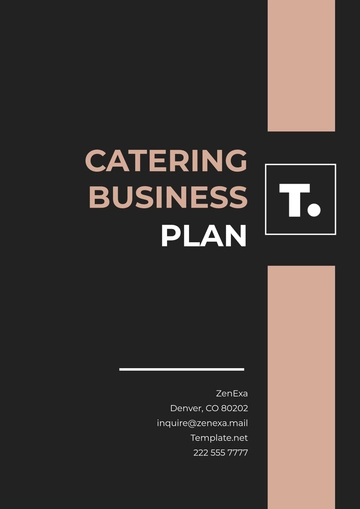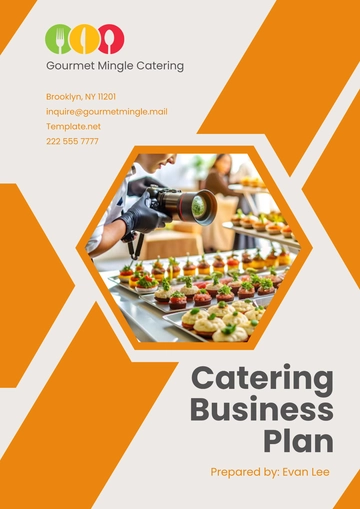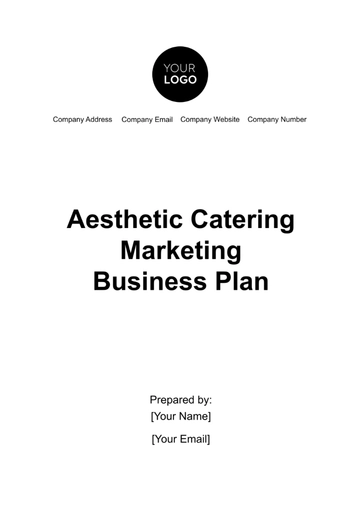Free Catering Business Plan

I. Executive Summary
A. Business Overview
[Your Company Name] is a full-service catering company established to meet the growing demand for high-quality food services in both corporate and social event spaces. Based in [Your City], [Your Company Name] specializes in providing customized catering solutions for a wide range of events, including weddings, corporate meetings, private parties, and large-scale festivals. Our mission is to deliver exceptional culinary experiences that enhance every event, contributing to memorable experiences for our clients and their guests.
In an increasingly competitive market, our commitment to quality, creativity, and sustainability will set us apart. We recognize that food is not just sustenance but an integral part of celebrations and gatherings, and our goal is to elevate these experiences through our culinary expertise and exceptional service.
B. Vision and Mission
Vision:
To be the premier catering company in the [Your Region], renowned for creativity, personalized services, and superior food quality by the year [2060]. Our vision is to inspire and delight clients with innovative menus that reflect current culinary trends and personal tastes.
Mission:
To offer a wide range of catering services that meet the unique needs of each client. Our services will be customizable, allowing clients to select everything from appetizers to desserts based on their preferences.
To maintain consistent food quality using fresh, local ingredients sourced from our trusted suppliers, ensuring that every dish not only meets but exceeds client expectations.
To ensure an outstanding customer experience through professionalism, timeliness, and creativity. Our team will be trained to provide exceptional service that leaves a lasting impression.
C. Business Goals
To achieve annual sales of [$1,500,000] by the year [2055]. This goal will be pursued through a combination of strategic marketing initiatives and exceptional service delivery, ensuring client satisfaction and repeat business.
To maintain a customer retention rate of [85%]. We aim to build lasting relationships with our clients, encouraging them to return to us for future events.
To expand the business into a new city by the year [2053]. Identifying opportunities for growth in other markets will be a critical focus in our expansion strategy.
To cater a minimum of [300] events annually by [2055]. This will be achieved by enhancing our marketing outreach and providing top-notch service to ensure word-of-mouth referrals.
II. Company Description
A. Company Name and Legal Structure
[Your Company Name] will operate as a Limited Liability Company (LLC) to provide protection for the owner’s personal assets while allowing flexibility in business operations. This structure not only shields the owner from personal liability in the event of lawsuits or debts but also enhances our credibility with clients and suppliers.
B. Business Location
Our main office and kitchen will be located at [Your Company Address], strategically positioned in the heart of the city, providing easy access to high-demand areas for events and food delivery. This prime location will allow us to serve a larger clientele while minimizing transportation time to various venues, which is crucial for maintaining food quality and service efficiency.
C. Core Services
Corporate Catering:
We offer tailored packages for business meetings, conferences, and corporate parties. Menus are customized based on the needs of each event, from simple breakfasts to multi-course dinners. We understand the importance of professionalism in corporate settings and strive to exceed expectations at every turn.Wedding Catering:
From intimate gatherings to large-scale celebrations, we specialize in offering personalized wedding menus that match the theme, cultural preferences, and dietary needs of our clients. We know that weddings are one of the most significant events in people's lives, and we take pride in making them unforgettable through our culinary expertise.Private Event Catering:
We cater to birthdays, anniversaries, and other private events, providing menus that fit the occasion and budget. Our team will work closely with clients to design a menu that reflects their personal style and preferences.Event Staffing:
Our service includes professionally trained waitstaff, bartenders, and event managers who ensure smooth operations from start to finish. The experience and professionalism of our staff are vital to creating an enjoyable atmosphere for guests and a stress-free experience for hosts.
D. Competitive Advantage
Personalized Menus:
Each menu is tailored to fit the client’s needs, preferences, and budget, allowing flexibility in offerings. We pride ourselves on listening to our clients and crafting menus that reflect their vision and tastes.Sustainability Practices:
[Your Company Name] sources ingredients from local farms and uses eco-friendly packaging materials, aligning with modern values of environmental consciousness. Our commitment to sustainability extends beyond food sourcing to include waste reduction and responsible disposal practices.Exceptional Customer Service:
Our team is committed to offering a seamless customer experience, from the initial consultation to event execution. We believe that attentive service can enhance the overall event experience and ensure our clients feel valued.
III. Market Analysis
A. Industry Overview
The catering industry in the U.S. is projected to grow by [5%] annually through [2055]. This growth is fueled by various factors, including an increase in social events, business gatherings, and the rising popularity of destination events. The growing trend toward sustainable, health-conscious, and innovative culinary solutions is also shaping the future of the industry, creating opportunities for companies that can adapt to changing consumer preferences.
B. Target Market
Corporate Clients:
Companies hosting annual meetings, team-building events, and holiday parties account for a large percentage of our clientele. We understand that corporate clients often seek efficiency, professionalism, and reliability, and we are committed to delivering on all fronts.Wedding Clients:
Couples looking for a one-stop-shop catering solution for their wedding receptions, rehearsal dinners, and post-wedding brunches make up a significant portion of our business. Our attention to detail and understanding of wedding traditions will appeal to this market segment.Private Event Hosts:
Individuals hosting birthday parties, anniversaries, and family reunions in search of hassle-free, full-service catering will also be a key target. We aim to simplify the planning process for these clients by providing comprehensive services.
C. Market Segmentation
Segment | Description | Percentage of Market |
|---|---|---|
Corporate Clients | Businesses requiring catering for meetings and events. | [45%] |
Weddings | Couples planning large and small wedding receptions. | [35%] |
Private Events | Individuals hosting social gatherings and private events. | [20%] |
Our segmentation allows us to tailor our marketing efforts and service offerings to effectively reach and serve each group.
D. Competitive Landscape
The local market consists of a combination of small, family-owned catering businesses and larger companies that focus on corporate events. The key competitors in our region are Competitor A, Competitor B, and Competitor C. We have conducted a thorough analysis of their strengths and weaknesses, enabling us to identify gaps in the market that [Your Company Name] can fill.
Our competitive advantage lies in our tailored menus, use of local ingredients, and commitment to sustainability, which sets us apart from larger, more generic catering services. We believe our focus on quality and personalization will resonate strongly with our target audience.
IV. Marketing Strategy
A. Branding
[Your Company Name] will establish a premium brand identity that reflects our commitment to high-quality food, personalized service, and sustainability. Our branding elements will include a professional logo, engaging website, and active social media presence. The branding strategy will emphasize our unique selling propositions, positioning us as the go-to choice for discerning clients seeking exceptional catering services.
B. Sales and Promotion Tactics
Website and SEO:
Our website will serve as an informational hub, featuring an online booking system, client testimonials, sample menus, and a blog with event planning tips. Search engine optimization (SEO) strategies will be used to ensure visibility for local event searches. Regularly updating the website with fresh content will also improve our ranking on search engines.Social Media:
We will maintain an active presence on [Your Company Social Media], sharing photos from events, menu highlights, and behind-the-scenes content to engage potential clients. Engaging storytelling about our events and community involvement will create a connection with our audience.Email Marketing:
A monthly newsletter will be sent to clients, featuring special offers, seasonal menus, and updates on our services. We will also include tips for planning successful events, which will position us as industry experts and keep our brand top-of-mind.Partnerships:
Collaborations with local venues, florists, event planners, and photographers will generate referral business. Building these relationships will create a network of trusted vendors, benefiting all parties involved and enhancing client experiences.Referral Program:
We will launch a referral program offering discounts or complimentary services for clients who refer new customers. This incentivizes satisfied clients to promote our services, leveraging word-of-mouth marketing.
C. Targeted Advertising
We will invest in paid social media ads targeting couples planning weddings, corporate event managers, and local businesses. The ads will showcase our culinary offerings, emphasizing our customization options. Additionally, we will utilize Google AdWords to capture local search traffic for terms like “corporate catering,” “wedding catering,” and “private event catering.” This focused advertising approach will help us reach the right audience efficiently.
D. Client Retention Strategy
Customer retention is critical to our long-term success. We will implement a loyalty program, offering returning clients discounts and priority booking for future events. Regular follow-ups after events will allow us to gather feedback, ensuring we continuously improve our services. Additionally, offering personalized notes and holiday greetings to past clients will reinforce our relationship with them.
V. Operations Plan
A. Facility Requirements
Kitchen Space:
Our commercial kitchen will be equipped with state-of-the-art appliances, including ovens, refrigerators, and food preparation areas. The kitchen will be designed to facilitate efficient workflow while adhering to local health and safety regulations.Storage:
We will maintain ample storage space for perishable and non-perishable items, ensuring that we can accommodate last-minute orders without compromising quality. Proper inventory management systems will be implemented to monitor stock levels and minimize waste.Transportation:
A fleet of reliable delivery vehicles will be essential for transporting food to events while maintaining freshness. Our vehicles will be equipped with temperature control systems to ensure that food remains at safe temperatures during transport.
B. Staff Requirements
Executive Chef:
The Executive Chef will oversee all culinary operations, menu creation, and food quality control. This individual will have extensive experience in catering and will bring a creative vision to our menu offerings.Sous Chefs:
A team of skilled sous chefs will assist in food preparation, cooking, and plating, ensuring a seamless flow in the kitchen during events.Event Managers:
Event managers will coordinate logistics, manage staff on-site, and liaise with clients to ensure that all event needs are met. They will be responsible for making on-the-spot decisions to handle any issues that arise.Service Staff:
A well-trained service team, including waitstaff and bartenders, will provide top-notch service during events. Regular training sessions will ensure that staff are knowledgeable about menu items and service standards.
C. Technology Requirements
Point of Sale (POS) System:
A user-friendly POS system will streamline order taking, payment processing, and inventory management, enhancing operational efficiency. The system will provide valuable data for financial tracking and sales analysis.Event Management Software:
This software will assist in scheduling events, managing client communications, and tracking event details. An organized approach to event management will reduce errors and improve client satisfaction.Marketing Tools:
We will invest in marketing tools for email campaigns, social media scheduling, and analytics to measure the effectiveness of our marketing efforts. This data will inform our marketing strategies and help us adapt to market trends.
D. Quality Control Procedures
Food Safety Training:
All staff will undergo comprehensive food safety training to ensure compliance with health regulations. Regular refresher courses will be conducted to maintain high standards.Menu Testing:
New menu items will undergo rigorous testing and tasting sessions before being introduced to clients. Feedback will be collected from staff and selected clients to refine dishes, ensuring we meet high culinary standards.Client Feedback:
Post-event feedback forms will be distributed to clients to gather insights into their experience. This feedback will be analyzed to identify areas for improvement, ensuring continuous enhancement of our services.
VI. Financial Plan
A. Startup Costs
The initial investment required to launch [Your Company Name] is estimated to be [$235,000]. The breakdown of these costs is as follows:
Expense | Amount ($) |
|---|---|
Kitchen Equipment | [$75,000] |
Leasehold Improvements | [$50,000] |
Initial Inventory | [$30,000] |
Marketing and Branding | [$25,000] |
Licenses and Permits | [$10,000] |
Working Capital | [$45,000] |
B. Revenue Projections
We project steady revenue growth over the next [5] years. Our financial forecast is based on market research and anticipated client demand.
Year | Number of Events | Projected Revenue ($) |
|---|---|---|
2050 | [100] | [$500,000] |
2051 | [150] | [$750,000] |
2052 | [200] | [$1,000,000] |
2053 | [250] | [$1,250,000] |
2054 | [300] | [$1,500,000] |
C. Break-even Analysis
To determine our break-even point, we will calculate the fixed and variable costs associated with our operations. The break-even analysis will help us understand how many events we need to cater to cover our costs.
Fixed Costs (per year)
Expense | Amount ($) |
|---|---|
Rent | [$36,000] |
Salaries | [$300,000] |
Marketing | [$24,000] |
Utilities and Miscellaneous | [$12,000] |
Total Fixed Costs | [$372,000] |
Variable Costs (per event)
Expense | Amount ($) |
|---|---|
Food Costs per Guest | [$50] |
Staffing Costs per Event | [$300] |
Transportation and Miscellaneous per Event | [$100] |
Average Guests per Event | [150] |
Total Variable Costs per Event | [$8,000] |
We need to cater at least [93] events annually to break even. Achieving this milestone will not only cover our costs but will also allow us to invest back into the business, enhancing our offerings and increasing our market share.
D. Funding Requirements
To cover our startup costs and initial operational expenses, we will seek funding of [$235,000] through a combination of personal investment, bank loans, and potential angel investors. The funding will primarily be allocated to kitchen build-out, equipment purchases, initial inventory, and marketing efforts.
In addition, we plan to explore grants and subsidies aimed at small businesses in the food service industry, which could provide further financial support and enhance our financial stability.
VII. Risk Analysis
A. Industry Risks
Economic Downturns:
Economic fluctuations can significantly impact the catering industry, as companies may cut back on event spending during lean times. To mitigate this risk, we will diversify our client base, focusing not only on corporate clients but also on weddings and private events, ensuring that we have multiple revenue streams.Competition:
The catering market is saturated with both small, family-owned businesses and larger, corporate entities. To stand out, we will consistently innovate our menu and services and focus on providing exceptional customer service that builds loyalty.Regulatory Risks:
Compliance with health and safety regulations is critical in the food service industry. We will ensure that all staff undergo regular training and that we adhere to local health department regulations, thus minimizing potential legal issues.
B. Operational Risks
Staff Turnover:
High turnover rates in the food industry can disrupt service quality and increase hiring and training costs. We will implement employee training programs, provide competitive compensation, and create a positive work environment to retain staff.Supply Chain Disruptions:
Unexpected disruptions in supply chains can affect food availability and costs. We will establish relationships with multiple suppliers to mitigate this risk and maintain a consistent inventory.Event Cancellations:
Events can be canceled for various reasons, impacting projected revenues. We will include clear cancellation policies in contracts to protect our revenue and have contingency plans in place to fill empty dates with other clients.
C. Financial Risks
Cash Flow Management:
Ensuring consistent cash flow is crucial for operational sustainability. We will implement effective financial management practices, such as maintaining reserves for slow periods, to navigate any unexpected financial challenges.Debt Management:
Relying too heavily on loans can strain finances and lead to solvency issues. We will plan our financing strategy carefully, focusing on building a solid revenue stream to manage debt effectively and minimize financial risks.
D. Mitigation Strategies
To address these risks, we will develop contingency plans, conduct regular financial reviews, and maintain open communication with clients and suppliers. This proactive approach will enable us to adapt swiftly to changing circumstances, ensuring the longevity and success of [Your Company Name].
- 100% Customizable, free editor
- Access 1 Million+ Templates, photo’s & graphics
- Download or share as a template
- Click and replace photos, graphics, text, backgrounds
- Resize, crop, AI write & more
- Access advanced editor
Create a roadmap for your catering venture with the Catering Business Plan Template from Template.net. This editable and customizable template allows you to outline your business goals, market analysis, and financial projections effectively. Use our Ai Editor Tool to personalize it, ensuring your plan captures the essence of your catering business.
You may also like
- One Page Business Plan
- Coffee Shop Business Plan
- Restaurant Business Plan
- Food Business Plan
- Real Estate Business Plan
- Executive Summary Business Plan
- Cover Page Business Plan
- Nonprofit Business Plan
- Daycare Business Plan
- Construction Business Plan
- Startup Business Plan
- Medical Business Plan
- Bakery Business Plan
- Service Plan
- Hotel Business Plan
- Catering Business Plan
- School Business Plan
- Healthcare Business Plan
- Transportation Plan
- Sports Plan
- Car Wash Business Plan
- Salon Business Plan
- Clothing Business Plan
- Farming Business Plan
- Boutique Plan


